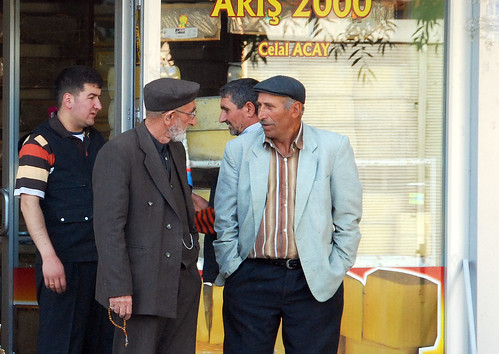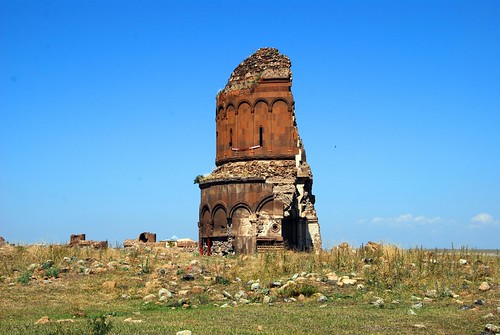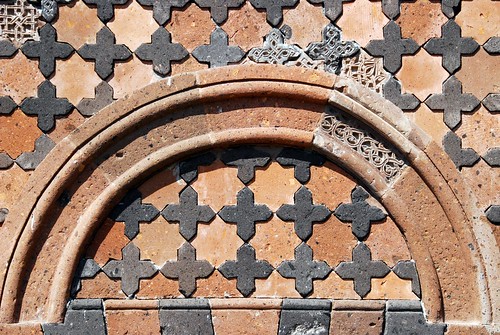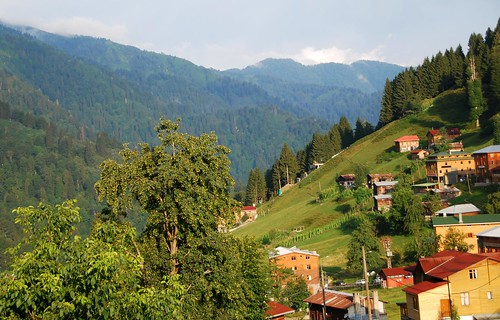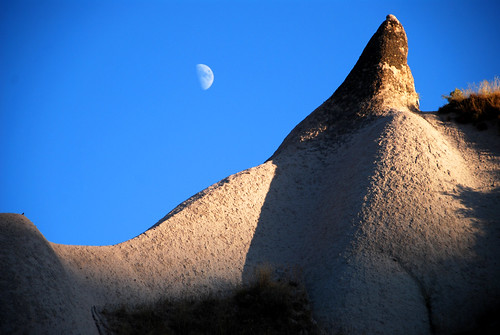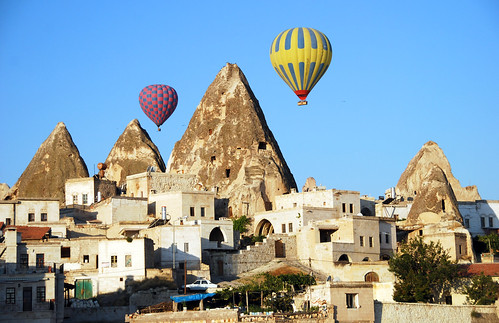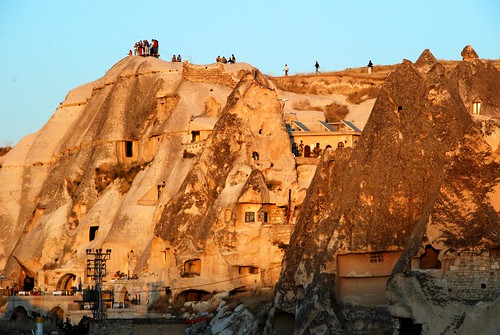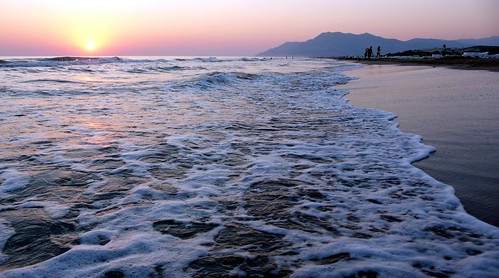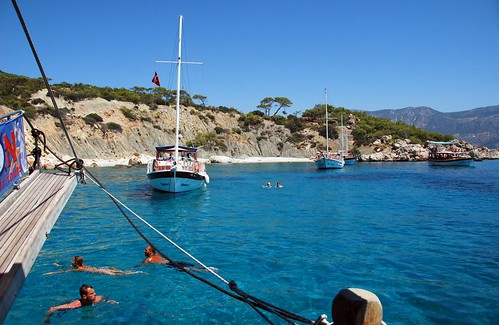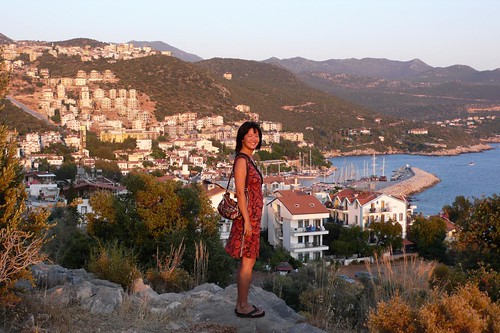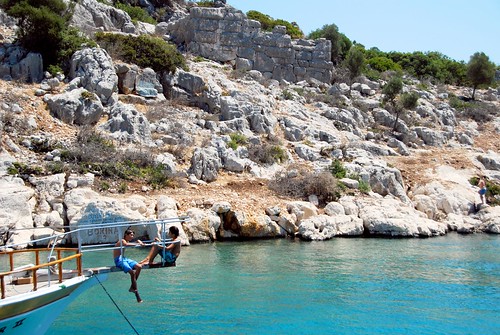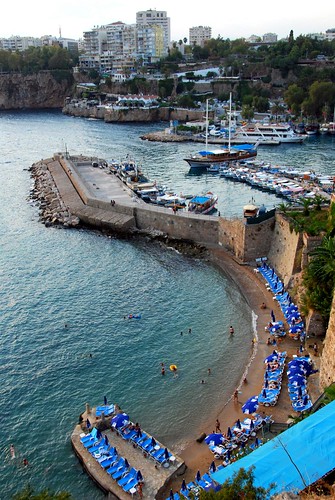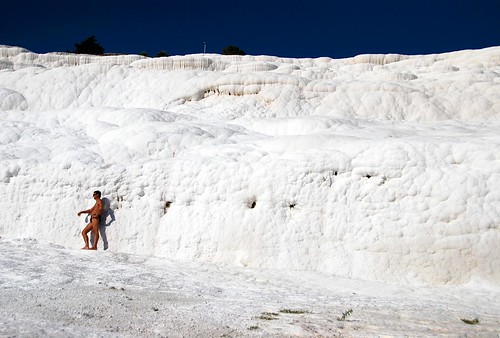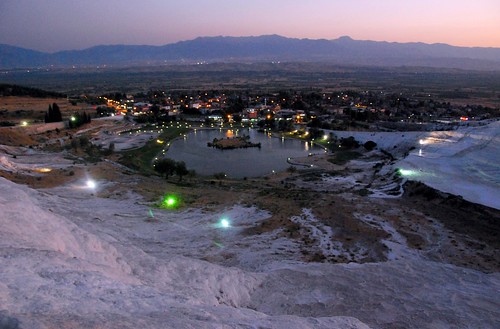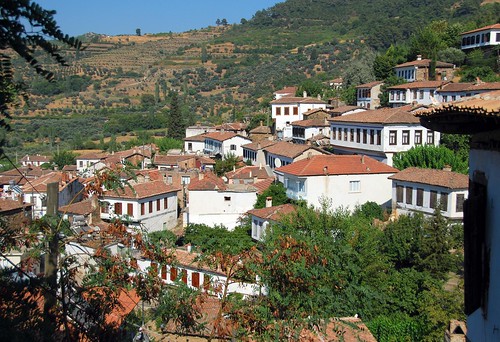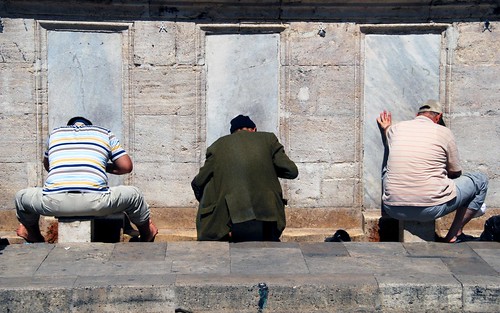Posts Tagged ‘Turkey’
I’ve been trying to find words that can capture the incredible affection we’ve developed for Turkey, and I’m afraid that nothing I write can adequately describe how amazing this place is. Like our three other favorite countries (New Zealand, Taiwan, and Japan), Turkey feels magical somehow. Maybe it’s the jaw-dropping landscape, maybe it’s the kind and generous people, maybe it’s all that incredible art and architecture. Or maybe it’s all three of those things. All I know is: this planet is a better place because of Turkey. Need we find more words than that?
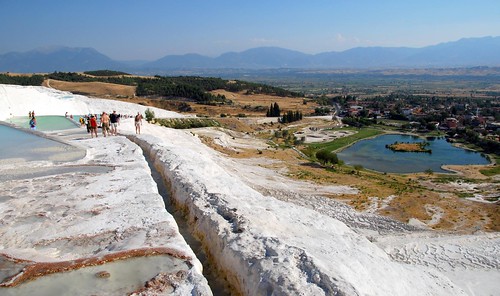
Jaw-dropping landscape. Check.
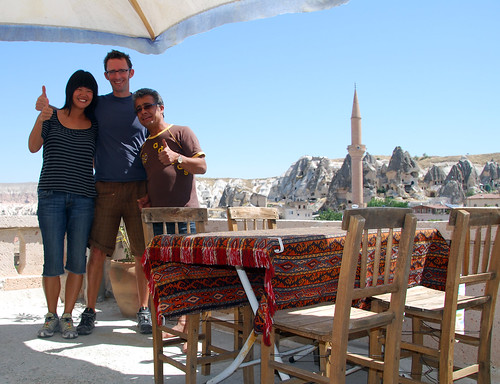
Kind and generous people. Check.

Incredible art and architecture. Check and double check.
Days spent here: 28 (August 11-September 8, 2009)
Highlights: Heads up, mouths agape in Istanbul, boat trips in the Turkish Mediterranean, exploring surreal landscapes in Pamukkale and Cappadocia, getting off the beaten path in Eastern Turkey.
Places we would like to visit next time: Mardin, and more of Eastern Turkey. Also, we’d love to explore the Black Sea coast in depth.
Average daily expenditures (for two people): US$120/day
Prices: There are rumors floating around that Turkey is not really the bargain basement European destination it once was, and while that’s probably true, once you get out of Istanbul, prices can drop dramatically. After a false start in Istanbul with THE WORST HOSTEL EVER, we moved to a much more pleasant place for €45 (US$60) per night. €45!!! (And that room was one of the cheapest we found.) As a comparison, we averaged about half that much for similar rooms in the rest of Turkey.
Food is also cheaper once you get out of Istanbul, but not as dramatically so. We averaged around $5-7 each for lunch and about $10-12 each for dinner. Breakfasts are usually included in the room price (see “Food” section below).
Museum and entry fees can pack quite a punch in Turkey (apparently all ticket prices doubled in 2008), particularly when you are charged to enter the complex as well as individual buildings within a site (ex. entering the Harem in Topkapi Palace), so choose your carefully!

Pattern overload in the Harem, Topkapi Palace.
Transport in Turkey is not dirt cheap, but it is an extremely good deal—you can bus halfway across the country (a 15 hour ride) in a comfortable, clean vehicle with stewards serving you tea and cakes for 55 TL (US$40).
Guidebooks we used: Lonely Planet Turkey and Tom Brosnahan’s Turkey Travel Planner. After finding the LP indispensable throughout Southeast Asia, we were disappointed with our Turkey guide. It’s perfectly passable if you are sticking to the country’s most heavily touristed areas: Istanbul and the Aegean and Mediterranean coasts. But once you venture off that well-beaten path, information in the LP is either incorrect, incomplete, or (in some cases) incompetent.
Luckily, Turkey Travel Planner was able to fill in the gaps where the LP failed. Tom Brosnahan has amassed excellent information on destinations that are not quite as heavily touristed. We also found his posts on the best Turkish bus companies and travel during Ramazan very helpful.
Weather: We were in Turkey late summer/early fall, and the west and central parts of the country were HOT. There were rumors that the Mediterranean coast hit 40°C (104°F) after we left. Yowza!!! I can’t imagine how stifling it must get in the dead of summer.
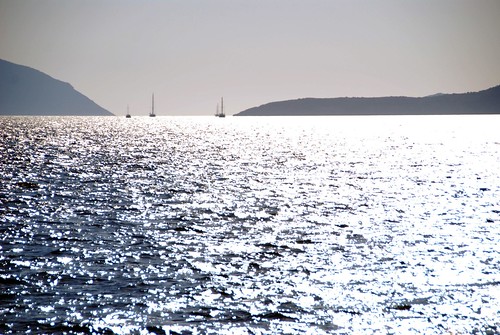
The Mediterranean coast’s relentless sun.
The eastern side of Turkey was quite temperate, however, and at times downright cold (And rainy. And foggy. Oh yeah, and hail-y).
Overall, it was an excellent time to visit, since the temperatures were relatively moderate during this time of the year.
Food: Traveling through west and central Turkey, we found the food to be tasty, but quite repetitive. Three weeks of doner kebap with a side of lettuce, tomato, and cucumber two times a day will do that to you. Turkish breakfast is more of the same, minus the kebap. You can imagine how hard it was to go from an English breakfast every day to this!:
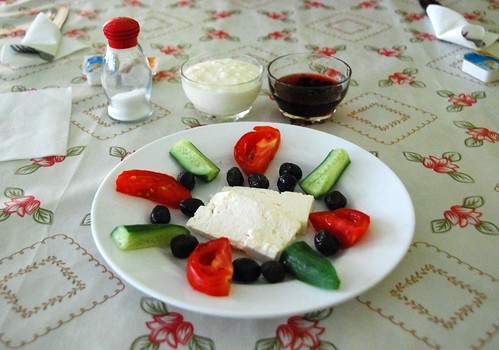
A typical Turkish breakfast: cucumber, tomato, feta cheese, olives (if you’re lucky), and bread.
As soon as we hit the east, however, Turkish food improved dramatically, both in taste and in variety. We ate Turkish fondue in the Kaçkar Mountains (at a lovely little family-run place named Yilmaz Cafeterya—if you’re ever in Ayder, you must go!), incredible lamb, yogurt, and eggplant dishes in Kars, and spiced ground beef with pine nuts stuffed inside a pastry shell in Van. So there you have it: east beats west. At least in Turkish cuisine.
Accommodation: We stayed in double rooms ensuite in budget guesthouses and pensions throughout Turkey and averaged about US$30 per night. Rooms and hotels in the east tend to be a little grungier than in west and central Turkey, but they are still adequately clean.
As I mentioned in a previous post, for the first time on the trip, we started going with the hotel touts whenever we arrived in a town (only in western Turkey—there were no touts in the central and eastern part of the country). Part of the reason is that touting in Turkey appears to be much more relaxed and low pressure (especially when compared to SE Asia)! We were never disappointed.
Transit: Turkish buses are amazing! Not only are they comfortable and clean, but little dudes in bow ties and cummerbunds serve you Turkish tea and cakes throughout the ride. Classy!

Turkish buses are nicer than this. We promise.
Internet: Every guesthouse we stayed in had wi-fi internet access either in the hotel or close enough to pilfer. The one exception was Ayder, though we were able to find a connection in the middle of town.
Culture: We’ve heard other people who’ve visited Turkey complain about how oppressed Muslim women are. We’ve heard solo women travelers complain about being sexually harassed. And we’ve heard tourists complain about being hassled at the markets.
I am sure all of those things are true. But if it wasn’t already clear by now, let me spell it out for you: our experiences with the Turks left us confident that they are the nicest, most generous, most hospitable people on the planet. Turkish people are AWESOME. Capital A. Capital W. Capital E. Capital SOME. AWESOME.
In short: It bears repeating: the world is a better place because of Turkey. ‘Nuff said.
You may know it as Ramadan, but it’s Ramazan to the Turks. Ramazan is the Islamic holy fasting month, when Muslims refrain from eating, drinking (even water), chewing gum, and smoking during daylight hours. It’s meant to remind Muslims of the difficulties the less fortunate face, and to teach compassion and charity.

The star and crescent moon (a symbol of Islam) on top of Topkapi Palace in Istanbul.
It can also have a bad rap amongst travelers: there are rumors that buses can be completely booked (true, but only at the tail end of the fasting month, when people travel celebrate the completion of Ramazan with their families), that people get snappy due to hypoglycemia and nicotine withdrawals, and that restaurants will close down in observance of the holiday, making life difficult for the non-Muslim traveler who flew all the way across the world to try some of that famous kebap.
All of this can be true (to degrees), but we found traveling in Turkey during Ramazan both fascinating and relatively painless. From our experience, there are two essential truths about this Islamic holy month:
- If you stick to the heavily touristed areas, you won’t be affected by Ramazan. Ramazan started while we were in Patara, and we traveled along the Mediterranean coast on through Cappadocia without even really noticing the holiday. Sure, there was the nightly drumming (see “Ramazan is LOUD” below), but we never had any problem finding food, and most restaurants were still serving alcohol. The only time we felt the burden of Ramazan was in the east, which brings me to my next point:
- If you get off the beaten path, you WILL be affected by Ramazan. As soon as we got off the bus in eastern Turkey, it was clear that we were going to have to change our public eating, beer-drinking, water-swilling ways. Restaurants were boarded up. Men were sitting around empty tables looking sad and listless. And not a soul on the street dared to smoke a cigarette (uncommon in this part of the world!).
If you find yourself in a town that observes Ramazan, there are a few things you need to know.
DO bring earplugs, because Ramazan is LOUD. From the local mosque ghetto-blasting the call to prayer several times a day, to the guy banging a drum in the wee hours of the morning…if there’s one thing that Ramazan is, it’s LOUD. Bring your earplugs, because otherwise you won’t get a wink of sleep.
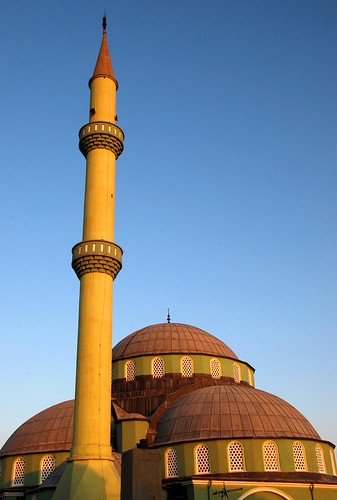
The green mosque in Van, right outside of our hotel window. Possibly a poor choice of lodgings during Ramazan.
During the fasting month, Turks wake up at the ungodly hour of 3 AM to prepare the morning meal before the sun rises. We were woken up every night in Cappadocia by the incessant beating of drums—the town crier trying to wake locals for their morning feast. It was obvious that Ayder had a smaller Ramazan budget—their human alarm clock had to make do banging some pots and pans together. And don’t think you’re out of the woods after the drumming stops—there’s the family of 6 staying in the room above you, making a huge ruckus as Mom starts preparing food and the kids are chasing each other around before their first meal.
DON’T eat in front of the locals if you are in a town that observes Ramazan. Again, we barely noticed it was Ramazan while traveling in western and central Turkey. But once we hit the east, we had to be more careful about eating and drinking water in public. It’s just plain rude to partake in front of fasters.
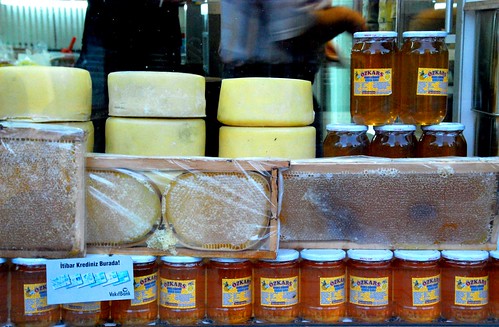
Buy, but don’t try (at least not in public). Kars’ famous cheese and honey.
Our attempts to stay out of sight while eating and drinking had us crouching in the back of an Ayder-bound bus, guiltily trying to Hoover our sandwiches before the aroma of fresh kebap could reach the passengers in the front. But try not to feel too racked by guilt, because:
DO realize that people will cheat during Ramazan (and DO try to find a restaurant BEFORE you get hungry, because it might take a while to find one). Most restaurants in Van (including their famous kavalti salonu—breakfast houses) were closed during the lunch hour while we were visiting. After wandering around for ages with our stomachs grumbling, we finally found a bakery that was open and asked the owner if he knew of a place where we could find a real meal. He walked us into a back alley, past a hidden room where Turkish men were drinking tea, into a shop whose windows were covered with newspaper, and our protesting stomachs were finally sated. Evidently this is where cheaters go for drinks and food when they’re desperate. I’ll be honest: cheating never tasted so good.
And I’ll never forget watching our friend in Cappadocia (who shall remain nameless, in order to protect the not-so-innnocent) crouching behind a wall, sneakily cracking nuts and drinking Fanta. Hey, even the devout get hungry.
DON’T worry that people are going to be cranky. We were concerned after hearing reports of impatient and hangry locals during Ramazan, but one look at our stories from Van and Cappadocia should convince you that nothing is the further from the truth. Fasting Turks can, however, be a bit listless. We saw clusters of old men sitting around empty tables on the street, looking mournfully at the spot where their tea glasses normally reside. Sad. ![]()

Some decidedly uncranky little troublemakers in Kars, all fired up before nightfall, when Muslims typically break fast.
DON’T try to eat dinner at 6:30 PM. Here’s a rule of thumb: 6:30 PM is the witching hour in Turkey. This is the time that Muslims are allowed to break fast, so the restaurants are PACKED with people, the waiters are frantic, and you may not be able to eat unless you have a reservation. Show up and 7:30, and you’ll eat in peace.
DO try to make Turkish people laugh during Ramazan. Who knows? You might get some free baklava. ![]()

Delicious Turkish treats in Van.
There’s no better way to understand Turkish culture than by observing it during Ramazan. We loved traveling in Turkey during the fasting month, and would encourage others to do the same…as long as you don’t mind a bit of drumming in the middle of the night. ![]()
There comes a time in every travel blogger’s life where you fall behind on your blog (four months in our case). And there comes a time when something so unexpected happens—something so amazing that it manages to infuse your cynical spirit with pure faith in the goodness of this world—that you feel like you can’t possibly wait four months to tell the world about it. This is one of those times.
Van is a town in southeast Turkey, set on the eastern shore of Turkey’s largest lake (called, fittingly, Lake Van).
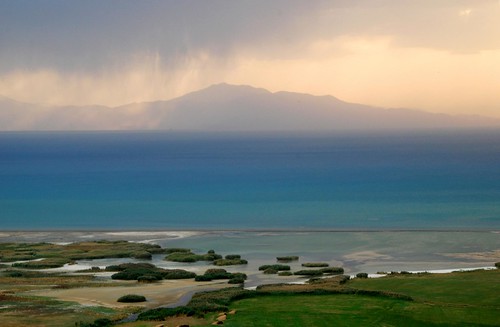
Storm over Lake Van. The lake is so large, some Turks refer to it as a sea.
At this point in our journey, we’ve learned a few lessons about traveling Eastern Turkey:
1. All the information in our guidebook is at best incomplete, and at worst incorrect
2. Nobody speaks English
Sure, this makes things like finding a hotel and getting around more complicated, but not insurmountable. But you know what is kind of hopeless? Trying to remain anonymous, even in a big town, because:
3. Everybody—and I mean EVERYBODY—will stare at you (if “you” happen to be an Asian woman)
Not in an aggressive way, and not in a judgmental way, but in a very, very curious way. If you ever wanted to know what it’s like to live the life of a bacterium under a slide, visit Van, Turkey.
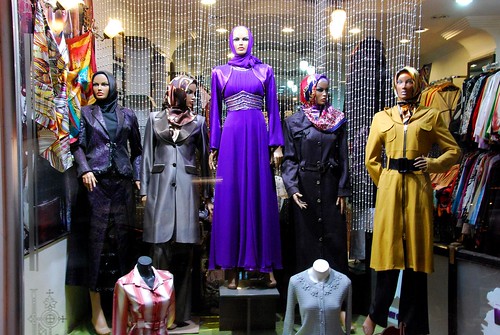
Am I being paranoid, or is she staring at me too?!?
One day, J and I decided to head out to tiny Akdamar Island in the middle of Lake Van, where there is a small but beautiful Armenian church. The ferry to Akdamar leaves from a point on the lake shore about 45 minutes away from Van. All we had to do was to find the bus to the ferry, but given lessons #1 and 2 of traveling in eastern Turkey, this was easier said than done.
On our way to the bus, we ran into a hotel owner who informs us that the bus stop for Akdamar has changed. He helpfully points “over there” to show us the location of the current bus stop, and we head on our way. Having walked about 15 minutes without seeing any buses, we ask some guys on the street. They also point “over there.” More walking. No buses.
We stop at a little cafe and ask directions. Some kids at the cafe overhear us and invite us to sit down and wait while they finish up their tea and snacks. Despite the language barrier, we understand that they will walk us to the bus station. But when we leave, they start walking in the direction we came from. We try to communicate that the bus stop has changed, but this is not getting across. We try one more time, pointing in the opposite direction. No dice. More desperate pointing. More walking in the other direction. Remember how I said lessons #1 & 2 made things “difficult”?
Eventually, we run into two of their friends on the street. One of them speaks English, so we explain our situation to him. He tells his friends that they have been walking us the wrong way, and a flurry of Turkish conversation ensues. And then:
English-speaking guy: My name is Mustafa. This is my friend Ozgur. We are going to take you to the bus station. And then we will take you to Akdamar. We will spend the rest of the day with you.
H + J: Wha? You don’t need to do that! You can just show us the bus stop. We can go on from there.
Mustafa: Turkish people love visitors. We want you to have a good time in our country. Ozgur and I will stay with you.
H + J: Are you sure?!? You really don’t have to do that…we can go on our own.
Mustafa: We want to. Come on, let’s go.
So this is how we ended up spending the day with Mustafa and Ozgur. They took us to the bus stop. They paid for our buses. They found another party at the dock to go out on the boat with us (the ferry does not run unless there are 10 people minimum). They spent their entire Sunday wandering around an island they have probably been to at least 30 times in their lives. They did this in the hot sun. During Ramazan. When they couldn’t drink any water.

Four new buddies on Akdamar Island: Ozgur, Jeremy, Mustafa, and Hope.
When was the last time someone asked you for directions and you not only took them to their destination, but you spent your entire Sunday with them AND paid for their buses? And then you thanked THEM at the end of the day for “giving you something to do during Ramazan.” I’m guessing, oh, NEVER. We were astonished by the generosity that Mustafa and Ozgur showed us.
But wait, there’s more! The next day, we head to Van Castle at sunset, with its sweeping vistas over Lake Van and bird’s eye view of the old ruined city of Van.

Jeremy, exploring the ruins of Van Castle (with Van Lake in the background).
And this is where we met Nevaf, who gave us a ride back to town in the middle of a crazy dust storm, took us out to dinner at a restaurant that Mustafa recommended the day before, and then invited us to drink beers (unlike many Turks, he is Christian) on the shore of Lake Van as the dark fell on our final night in Turkey.

Incredible sunset over Lake Van.
So, wow…Van. Sure, the Church of the Holy Cross on Akdamar was very beautiful.
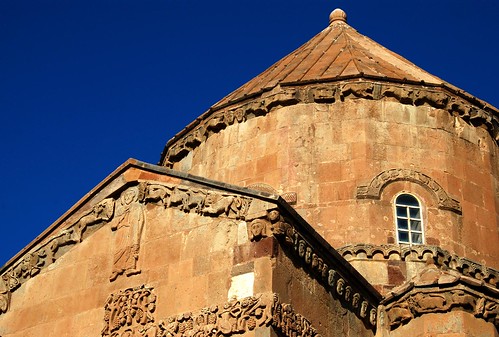
Detail of the Church of the Holy Cross on Akdamar Island. It is covered with gorgeous stone carvings on the outside and religious murals on the inside.
And we’ll never forget watching that sunset from the top of Van Castle.

Gorgeous sunset light framed by the ruins of Van Castle.
But we’ll always have a special little warm feeling in our hearts whenever we think of Van…and that is because of the generosity of both time and spirit shown to us by three Turkish friends. Thank you, Mustafa, Ozgur, and Nevaf, for showing us what true Turkish hospitality is all about.
Transportation from Kars to Van: Our bus ride from Kars to Van was so painless I can’t even remember it. Nice to have some of those every once in a while. 30 TL (US$20) per person.
Where we slept in Van: In a town with only a few budget options, Otel Bahar (right next to the big green mosque) delivers. Clean, spacious rooms, nice views of the mosque on the upper floors, central location, and free wi-fi. 50 TL (US$33) for a double room ensuite.
As an around-the-world traveler, you tend to hear a lot of the same questions: What are your favorite countries? How much does a trip like this cost? Where do you do your laundry? But every once in a while, you’ll get a query that really stops and makes you think. Do you become blasé about amazing sights because you see them every day?
Well shoot, that’s a good question. Do we?!?
I’ll admit that some of the places we’ve visited have not seemed as impressive as they would have had we visited under different circumstances. I’m sure I would have been blown away by Ephesus or Krabi or Xian had we visited straight from SF.
But we’ll get back to that in a second. For now, let’s cut to Ani, the former capital of Armenia. Ani is a site in eastern Turkey that is literally yards away from the Armenian border.
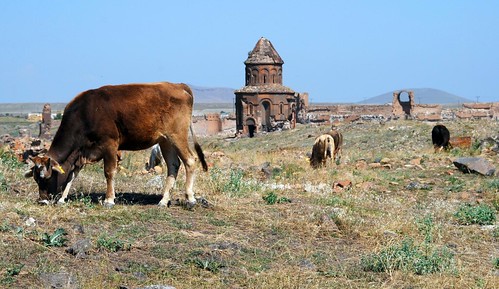
Cattle worshipping at the Church of St. Gregory in Ani.
The closest town to Ani is Kars and frankly, there is not much reason to go there except to visit Ani. A run-down, Soviet-style town, Kars is pretty far off Turkey’s beaten path…so much so that within an hour of getting off the bus, the guy who is mentioned in our Lonely Planet as a reliable guide finds us, along with pretty much every other tourist in Kars (there were 10 of us). Still, Kars grew on us, despite the dilapidated buildings and the uninteresting city plan (a Soviet-style grid).
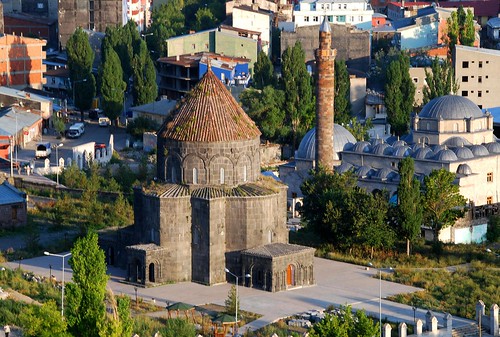
Bird’s eye view of the Armenian-style church and mosque in Kars.
It’s a 1.5 hour long ride to Ani from Kars, and the 10 of us tourists hopped in a van to visit these Armenian ruins. Along the way, we got to know our fellow travelers: 4 older Brits, an American, a Spanish guy, and a couple from Switzerland. And despite the fact that Jeremy and I were a bit “ruined out” at this point in our Turkey travels, we were still excited to be visiting Armenian-style ruins that so few visitors to Turkey get to see (indeed, our bus contained the only visitors to Ani that day). We pay our 5 TL entrance fee and wander through the old city walls:
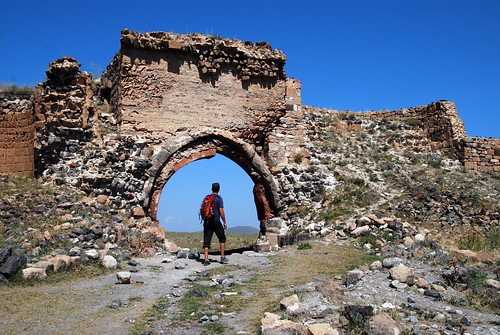
Jeremy framed by the old city walls.
And this is when the Spanish guy says:
“Ahhh! This is SHIT!”
Uh, excuse me, Spanish guy? Really?!? THIS is shit? Apparently our Spanish friend was a big photographer, and the lighting conditions at 11 AM were unacceptable to him. The first 10 minutes of our visit to Ani was narrated by Mr. Wet Blanket: “This isn’t Ani! You should look on Flickr if you want to see real pictures of Ani! I should have come at sunset!”
Quickly deciding that the Spanish guy was harshing our buzz, Jeremy and I lost him and wandered around Ani’s vast, empty grass plains on our own.
It really was a beautiful place. The cows grazing in the fields, the rugged valleys, the intricate stonework, and the panoramic views to Armenia…all of it colluded to make us believe that Ani was somehow magical.
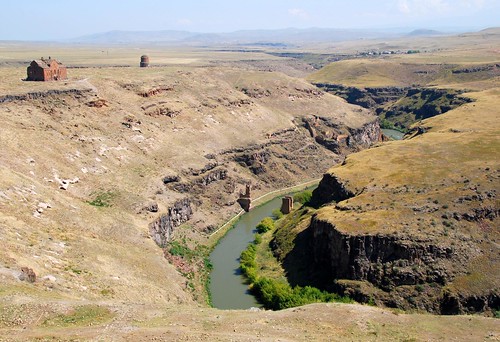
Turkey on the left, Armenia on the right (separated by the Araks River).

Hope framed in the doorway of the Ani Cathedral.
And to answer your question: No, I don’t think we’ve become blasé about amazing sights.
Transportation from Ayder to Kars: First, the bad news: our first bus driver stuffed about 25 people in a van made to seat 15, we had no idea if we would actually make it to Kars due to the language barrier, and our third bus broke down in the middle of nowhere. Twice. Now for the good news: the trip from Ayder to Kars was the most breathtaking bus ride we’ve taken so far on the trip. We traveled from the lush greenery of the Kaçkars’ Black Sea side to the dry, rocky landscape of the south side. And then it was on through verdant pasture lands, mountains with ramshackle stone houses built into their sides, little boys herding cattle through dry, golden steppes, and whole families riding home in donkey carts after a day of working in the field.
Due to MASSIVE CONFUSION as a result of the language barrier in this region, we have no idea how to advise you on getting from Ayder to Kars. Just know that (1) you can do it (we didn’t even know that much before we got on the bus), and (2) it will cost you 55 TL (US$35) each for the entire trip.
Where we slept in Kars: Though the Güngören Hotel (50 TL or US$30 for a double ensuite) is pretty rough around the edges, so is the rest of Kars. It’s not much to look at, but the rooms are pretty big and the staff is nice.
If you’ve been following along, you know by now that Turkey has got it all: a wandering coastline bordering lucid blue waters, a cosmopolitan city wrapped around a chewy historical center, snowy white rock springs so lovely that visitors are moved to strip down to their Speedos (in a Muslim country no less), and a surrealist landscape that would make Dali proud. We saw all these amazing sights in west and central Turkey, so it was time to move to the northeastern corner of the country to check out some good, old-fashioned mountains.
The Kaçkar Mountain Range is a famous trekking area in Turkey. However, Turkish trails, especially in this region, are notorious for being badly signposted. We were strongly advised to find a guide, even for a day hike. But when Jeremy and I researched 3- and 4- day treks through the Kaçkars, we found them to be prohibitively expensive—often over €600 per person! Figuring we would have better luck finding a decently-priced guide once we arrived in the Kaçkars (after all, companies who advertise on the internet are often more spendy), we put ourselves on a bus headed northeast (for more on that saga, read the Transportation section below) and crossed our fingers. The eastern side of Turkey is much less touristed, and information on the area is either scarce or outdated. But everything has always worked out before…why should this time be different? (And this is the point in the movie where you would be screaming, “No! Don’t walk through the door! There’s a monster hiding in there!!!”)
There are two ways you can approach the mountain: on the Black Sea side (in which case a little town named Ayder would be your home base), or via the southern side of the mountain (Yusufeli). Our guide book recommended Ayder as a good place to organize treks, and we had no reason to doubt the LP’s accuracy. (MONSTER!!!!)
We reached Ayder exhausted, hungry, and delirious (17 hours of bus rides will do that to you). And then there was The Hill. See, Ayder’s bus stop sits at the bottom of a long, steep hill…and naturally all the guest houses are a several huffs and puffs from the station.
We were in for more surprises. First of all, Ayder was dead. We could barely find a soul on the street, much less someone to take us up the mountain. Of the few people who we could find, no one spoke English. How exactly are we supposed to find someone to take us hiking?
We literally wandered all over the town of Ayder, trudging up and down the hill, from one place to the next, pantomiming our desire for a mountain guide. After a couple of hours of this, we had downgraded our expectations from “multi-day trek” to “day hike.” Tired, hungry, and frustrated, we gave up for the day and stopped into the closest restaurant for dinner, hoping our hiking plans would miraculously work themselves out by morning. And what do you know? Not only did we find a very sweet family serving amazing home-cooked food, but even better—a couple of Israeli tourists stopped in after completing a 3-day trek and we peppered them with questions about hiking in the Kaçkars. From this we gathered: catch the 10AM bus to Kavrun and organize a trek from there. Success!!!
After a few false starts (the bus leaves at 10AM, no—9AM, no—9:30. Ish.), we take an hour and a half to arrive in Kavrun, even though it is only 30 km away (blame the terrible roads…and the tea stop). This gave us plenty of time to meet other English-speaking travelers on the bus: a German couple, and two Turkish guys.
It’s true: you can find a guide in Kavrun. The Turkish guys got to work trying to negotiate a price for a guide to take all 4 of us up the mountain (the Germans opted out of the hike), but when that price is deemed too high, we decide that we can find our way as a group. What could possibly go wrong with this plan? (The monster—he’s right behind you!!!!)
Long story short: about 3 hours into our trek, the weather turned bad. As in, really bad. As in, rain + fog + thunder + lightning + hail kind of bad. So bad you can’t see 10 feet in front of you kind of bad.

The town of Kavrun, enveloped in fog. This photo was taken 2 minutes after the photo above.
Jeremy and I decided to turn around, but the Turkish guys stubbornly decided to keep looking for our final destination (a group of alpine lakes). Ten minutes after we left them, Jeremy and I found the lakes. Our group had walked right by them on the way up, but the thick fog obscured our view.
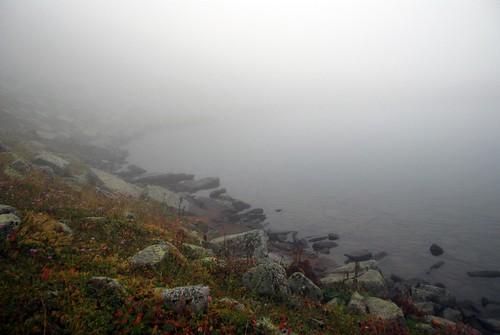
How could we possibly miss this?!?
After a few scary moments of losing the trail in severe weather, J and I finally found the original path and booked it down the mountain as fast as we could. We were cold and soaked to the bone, but we were happy with our decision to turn around.
We finally made it back to Kavrun’s little cafe and joined a group of Israelis and the German couple warming themselves by the fire. And here’s where the story really gets interesting. Turns out the bus driver was waiting for the 4 of us to return from our hike before he was willing to make the drive back to Ayder (perhaps he communicated this to the Turks, but J and I had no idea). The Israelis and Germans had been waiting ALL DAY for us, and were understandably upset about this. But given that this was the only bus back to Ayder, we didn’t want to leave the Turkish guys on the mountain. They weren’t properly dressed and the weather was really bad. So we waited.
And waited.
And waited.
And then we worried. Well, at least Jeremy and I worried. Everyone else was pissed off and wanted to get going. But the bus driver stuck to his guns—he wasn’t going to leave the two Turkish guys stranded in Kavrun without a ride back to Ayder.
More waiting.
Finally, one of the Israeli girls harasses the bus driver long enough that he agrees to leave. We ask the guides at the cafe to go looking for the Turks if they don’t show up before 5PM. On our way out, J and I kept looking out the windows, searching for our lost Turkish friends. We hope they made it back safe.
Transportation from Cappadocia to Ayder: Despite warnings from the bus ticket vendor (we thought he was just trying to close the sale), J and I wait until the day of to buy tickets from Cappadocia to Ayder and find that they are sold out. Note to future travelers of this route: Buy your tickets several days in advance! This is a not a heavily traveled route—there are only 2 bus companies that make the trip each day.
We also found that the Lonely Planet has either outdated or incomplete information on this region. The guidebook said there were direct buses from Rize to Ayder, but after an exhausting overnight bus ride from Cappadocia to Rize, we found (after much pantomiming) that we had to take a local bus to the Rize minibus terminal, catch another bus to Pazar, where we could catch a direct bus to Ayder. Since our original bus from Cappadocia was headed further east, life would have been a lot easier if we just got off the bus in Pazar rather than Rize. Another note to future travelers: don’t blindly trust the Lonely Planet! Always double check the info you get from your guidebook, especially in “off-the-beaten-path” destinations. It could save you a lot of pain and frustration.
All of this travel was during Ramazan. So prior to getting on the bus to Pazar, we bought a kebap, and then proceeded to try to eat said kebap on the bus without any of the locals seeing (it’s rude to eat in front of fasting Muslims). I have never in my life felt so guilty for eating a sandwich.
Where we slept in Ayder: We found a cheap (50 TL for double ensuite), comfortable little family-run place about 2/3 up the hill in Ayder, called something like Uçhisar or Uçhalar Pensiyon (sorry, notes are thin for this region). Can’t say I recommend the place, as the showers were not hot. There’s nothing like taking a lukewarm shower after getting drenched in the Kaçkars. Can’t say I recommend that, either.
It’s not often that party banter will bring you half way around the world. Before we left on our trip, we met a California surfer at a party, and after finding out he had been to Turkey several times, we asked the obvious question: “What we shouldn’t miss in Turkey?” His answer:
“Cappadocia, dude.”
Even with this glowing recommendation, and even though Cappadocia is so stunningly weird that it is featured on our guidebook’s cover, we still weren’t prepared for the sheer surreality of the landscape.
Cappadocia (which is actually a very large region in Central Turkey, though most people only visit the 60 radius miles or so around a town called Göreme) is known primarily for its unique rock formations called “fairy chimneys,” which come in all shapes and sizes. Some look like teepees, some look like mushrooms, some look like little guys wearing hats, and others look like…um, asparagus (or something more X-rated if you are of that persuasion). But like a bottle of wine that you buy because you like the label, only to be pleasantly surprised to find that it actually tastes decent, Cappadocia is more than it seems on the surface. Sure, the multi-colored landscape is incredible, but there are many more sights and activities in this region to sustain a traveler for the better part of a week.
But you gotta start somewhere, right? So let’s start with judging this book by its cover.
Fairy Chimneys and Rock Houses
Cappadocia’s natural beauty is impressive enough as it is, but take that Dali-esque environment, throw some humans into the mix, and that’s when things really get weird. Believe me, I like my nature as unspoilt as the next traveler, but I think Cappadocia’s landscape is fascinating because of the way ingenious locals have altered and interacted with their environment. The volcanic rock that comprises Cappadocia’s fairy chimneys is soft enough to be carved, yet it hardens when it comes in contact with air, so that the interior of these tent-shaped structures can be sculpted into rooms, stairs, and windows—ancient pre-fab homes!
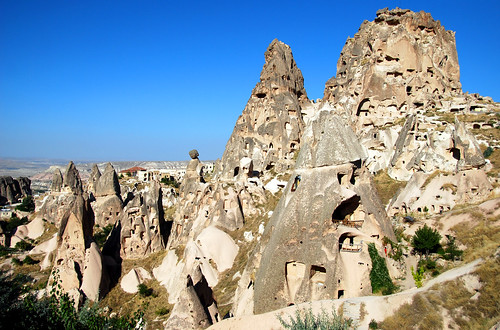
Uchisar Castle surrounded by rock houses.

Rooms cut into the side of a cliff. The small arched coves are dovecotes. The people of Cappadocia were agricultural, and they gathered pigeon guano for use as fertilizer.
And why would you stop at building houses? In Göreme’s Open Air Museum and Soğanlı Valley (which we reached via scooter after failing to realize that it was more than 50 miles from Göreme, much to the chagrin of our butts), you can wander through rock-cut churches covered in colorful murals. Unfortunately, some of the murals have been damaged by ancient graffiti cut into the rock. We saw names carved with dates as far back as the early 1800s! I guess disrespect is timeless.
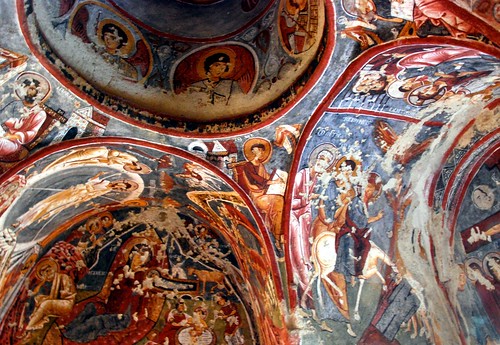
Interior ceiling of one of the rock churches in Göreme’s Open Air Museum.
How’s the view?
It’s all about the view in Cappadocia. A popular thing to do in this region is to take a sunrise hot-air balloon ride, but at €250 per person, this just wasn’t in our budget. We were happy to save our dough and watch from the roof of our pension as the balloons glided silently over Göreme.
Lucky for all of us who can’t afford a €250 per person balloon ride, there are plenty of places to catch a breathtaking view in Cappadocia. The most popular viewpoint is from atop Uçhisar Castle:
Our favorite viewpoint was discovered by accident, when we climbed to the top of Cavuşin Old Village. Unbelievably, this place is not mentioned in the Lonely Planet!
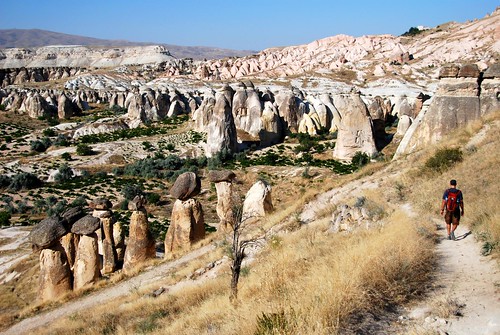
Hiking down the back side of Cavuşin Old Village.
The sunset spot in Ortahisar (entry fee=1 TL) ain’t too shabby either, though it is only accessible via car (or scooter). For those on foot, there’s always the sunset spot in town.
Let’s take it down a notch
Not only does Cappadocia have a lot going for it on land, but below, too! In order to hide from persecuting Romans, early Christians carved out underground cities with up to 8 levels, with ingenious air shafts that allowed ventilation. Our favorite feature of these underground cities were the rolling doors, which sealed off crucial passageways in the event of an attack. These doors have a small hole carved out of the middle of the wheel—just big enough to fit a spear intended for any invading Romans.

A rolling door in Derinkuyu underground city.
There are several underground cities in Cappadocia, but we visited Derinkuyu because it is the one underground city that the tour buses don’t visit. Unfortunately, we failed to realize that a lack of tour buses also meant a lack of tour guides (many other travelers strongly advised hiring a guide because they can make the underground cities come alive). I was just starting to get bummed out about our guidelessness when a local boy and his friend introduced themselves to us and started leading us on their own informal tour. We crawled in and out of passageways (underground cities are not for the claustrophobic) with these two Turkish teens, and even though they only spoke basic English, we had a waaaay better time exploring with the two of them than on any stinkin’ tour!
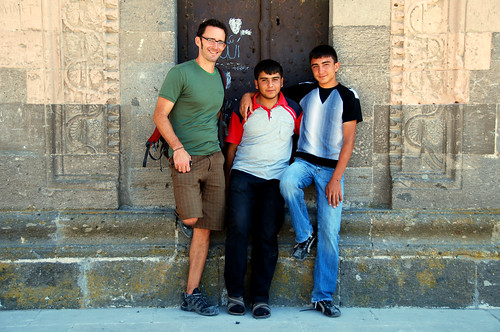
Jeremy posing with our Derinkuyu tour guides.
At the end of our informal tour, our wary “travelers’ shells” had us anticipating a tip request, but it never came. Which brings me to my next point:
Cappadocian people are awesome
Cappadocia taught us that a friendship could be formed by something as simple as a sneeze. Picture it: we’re walking down the main street in Göreme, when Jeremy sneezes so hard his backpack flies off. A bunch of listless Turkish men suddenly start laughing and a tall, handsome local man with a big gap-toothed smile approaches to invite us into his bakery. He offers us free baklava, with the following explanation:
“It’s not easy to make a Turkish man laugh during Ramazan!”
And this is how we came to meet the best baklava we’ve ever tasted: not too sweet, not too soggy, and not too crispy. Just pure honey-soaked, flaky goodness. After “The Sneeze Heard ‘Round Göreme”, our friend at Nazar Börek always greeted us with his big, gap-toothed smile, and we always stopped to chat with him and eat a few pieces of his baklava. And it all started with that sneeze.
Traveling through surreal lands
Hiking is another big draw in Cappadocia. There are several trails close to Göreme that take you through valleys with abandoned rock houses, though the majority of the hikes (with the exception of the Rose and Red Valley trails) are very confusing and badly (if at all) signposted. Note to Turkish entrepreneurs: someone could make a killing off an accurate trail map.
Our favorite hike was recommended by none other than our baklava friend. There is some confusion as to the name of this trail, as it was called Pigeon Valley on one map and Love Valley on another—just know that it is the valley linking Uçhisar and Göreme. Despite the fact that it is a very difficult trail to find, it’s a winner!
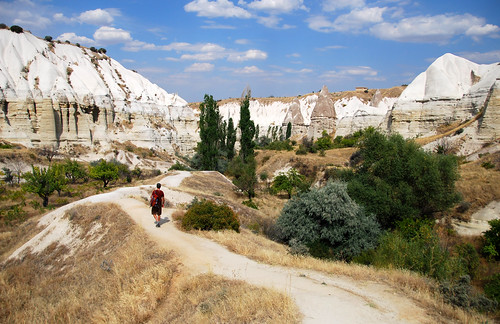
Our favorite hike in Cappadocia.
In conclusion, Cappadocia has it all: amazing landscape, incredible people, great baklava, interesting historical sites, and nice outdoor walks. It took us 8 months and who knows how many thousands of miles to realize that the California surfer said it all. Cappadocia, dude.
Transport from Antalya to Cappadocia: There are several buses each day from Antalya to Cappadocia, though most of them are night buses. Ignoring the fact that it sucks to sleep on a bus, we prefer day buses because you get to see so much of the country. Some people might argue that you lose a day traveling, but we feel like you gain a better understanding of the landscape when you bus during the day. It’s a 10 hour ride from Antalya to Cappadocia, and on Metro Bus, the trip’s a cool 70 TL (US$23) each.
Where we slept in Cappadocia: We’re pretty convinced that we found the hostel with the best view in Göreme. Kookaburra Pension is run by a crazy (in a good way), sweet (see “Cappadocian people are awesome”), funny guy named Ihsan. The rooms have a homey feeling and the view on the upper deck is spectacular. At 60 TL (US$38) for a double ensuite, it’s not the cheapest place in town, but it might just be the best.
What comes to mind when you hear the word “Mediterranean?” Heat. Blue. Yachts. Olives. And…Turkey? Yup, Turkey shares that same incredible blue sea…the same glorious shining sun…that same fresh, delicious cuisine…and all at about a quarter the price of those Western European countries.
When we were in Istanbul, J and I met a really nice Finnish guy who told us about his favorite places in Turkey, and Patara (a small town with a 20 km beach and ancient ruins right past the sandy shore) was high on the list. So to Patara we went! It was our first stop on Turkey’s Mediterranean coast, and our Finnish friend was right…it’s a nice frickin’ beach!
A beach like Patara can hold any traveler hostage for several days, but what really stood out about our stay in Patara was our pension. Once again, we went with the hotel touts at the “bus station” (if by “bus station” you mean “random spot on the highway”), and once again, we weren’t disappointed. J and I ended up in a room at Rose Pension, which is a warm, family-run place that felt like a home away from home…if yo momma is Turkish. For a few days, we felt like we were part of one big, happy Turkish family, with other travelers from Italy, Russia, and Belgium as our siblings.

The Rose Pension family: Mehmet, Hope, Mesut, our Turkish momma, and Jeremy.
One day, some of our Belgian and Turkish “brothers and sisters” invited us on a boat trip with them from nearby Kalkan. By the end of the day, we were HOOKED.
What a incredible way to spend a day…motoring from island to island, swimmin’ hole to swimmin’ hole. And at 35 lira (approx. US$20) each, including a yummy buffet lunch, we thought it was the best deal in Turkey!
We planned to stay in Patara for several days to relax and swim in the ocean (an activity that has really captivated us since our visit to Ko Lipe), but we ended up moving on after a few days because:
- The beach is pretty far from town. We were told that it was a 1 km walk, but we didn’t realize that it was actually a “Turkish kilometer” (i.e., anywhere from 2 blocks to 4 km).
- The beach is indeed big, but there is nowhere to hide from the overpowering sun, unless you pay to use some umbrellas and loungers crowded together on one small plot of beach. The result? A very crowded 0.5 km of sand, with 19.5 km completely void of people.
- Mosquitos. ‘Nuff said.
So, after a few days hanging out in Patara and enjoying our temporary Turkish momma’s amazing cooking, we hopped on a bus towards another town along the Mediterranean called Olimpos. On the way there, we got a bit sidetracked when we met a really nice Dutch guy who lives in Patara part of the year. He recommended we check out a town called Kaş, so at the last minute, we hopped off the bus before our intended destination. Once again, taking the advice of a fellow traveler was the right move. Kaş had everything we wanted: good food, a view of the water, and more boat trips! There are also some nice ruins in town, where you can watch the sunset.
Our Dutch friend also supplied us with one of our favorite quotes of the trip. I was asking him about the British travelers who come in for the weekend and fry themselves to a crisp before returning to the rainy UK, when he exclaimed, “I know! They come in looking like a glass of milk, and they leave looking like a bottle of rose!” Thank you for the comedic interlude, funny Dutch guy!
And another thank you to our funny Dutch traveler for convincing us to check out Kaş. We loved it there! Day after day was spent enjoying the sea…either via boat (where you can explore sunken ruins), or by lounging on one of the “beaches” in town (a lot of the Mediterranean coast in Turkey is rocky, so restaurants will set up a bunch of loungers on a rocky outcropping, and you can use the beds for free, with the implicit agreement that if you want something to drink, you buy it from them).
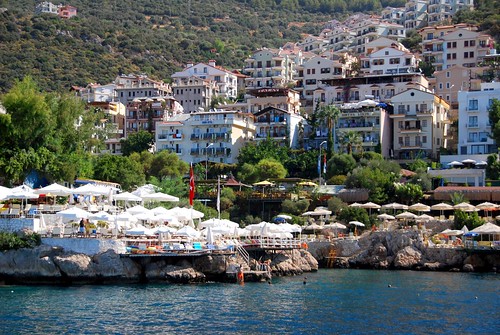
View of the rock “beach” restaurants in Kaş.
Each night, we dined at one of the many delicious open-air restaurants in Kaş. Turkish food can be pretty repetitive—kebap with cucumber, tomato and olive is really delicious for the first week, but the same meal for lunch and diner every day gets pretty boring. Luckily, Kaş has a pretty developed culinary scene, and we happily dined on freshly caught fish and homestyle Turkish casseroles.
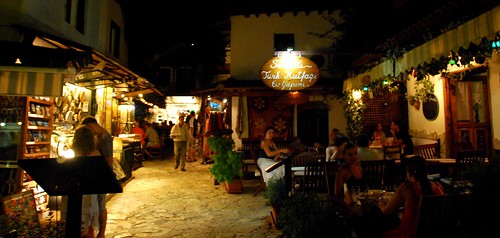
A cute street full of outdoor dining options in Kaş.
Each night after dinner, we’d ask each other “should we stay one more day?” And the answer was invariably “YUP!” But eventually, we had to tear ourselves away from Kaş. Our final stop on Turkey’s Mediterranean coast was Antalya, mostly because it is a major transport hub, but it turns out the Kaleiçi (Old Quarter) in Antalya is quite charming!
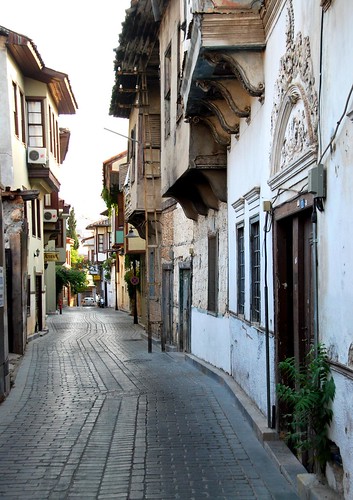
Street scene from Antalya’s Kaleiçi.
Antalya’s also got some surprisingly nice beaches for such a big, bustling city, though you do have to pay to use them (8 lira for this beach, or about US$5…which is pretty steep by Turkish standards, but we were desperately hot).
Though we only spent one night in Antalya, we managed to cover it all in this city—our single day was spent exploring the Old Quarter, topped off with just a little more time enjoying that incredible blue sea.
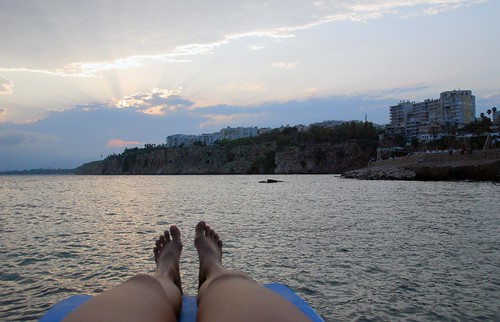
Our last evening on the Mediterranean.
And with that, the sun set on our Mediterranean excursion. ![]()
Transportation from Pamukkale to Patara (and Kaş and Antalya): There are no direct buses from Pamukkale to Patara. You must take a bus from Pamukkale to Fethiye (16 lira each, approx. US$10) and catch a bus that drives the Fethiye to Antalya route, where you can hop off on the main highway near Patara (10 lira or US$6 each). From there, you have to catch another bus that will take you down the hill into town.
From Patara to Kaş and then to Antalya, you have to catch that same highway bus that runs between Fethiye and Antalya. It cost us 7 lira (US$4.50) from Patara to Kaş and 16 lira (US$10) from Kaş to Antalya.
Bus prices along this route can be pretty arbitrary, and tourists invariably get charged more than locals. There doesn’t seem to be a system for when you pay: you can hand over your hard-earned lira at the beginning, end, or middle of the ride. Miraculously, the driver somehow keeps track of who has paid and who hasn’t, making change while driving the windy roads. Turkish multi-tasking at its finest.
Where we slept in Patara, Kaş, and Antalya: Though the rooms at Rose Pension in Patara (double ensuite with AC and deck for 45 lira, or approx. US$30) are pretty standard, the homey feeling makes it a total standout. We even received a couple emails from Mesut asking about our travels and wishing us a Merry Christmas! Plus, our Turkish momma is an absolutely incredible cook. Rose Pension MADE our Patara experience.
In Kaş, we stayed at Hilal Pension in a double ensuite with AC and deck for for 65 lira (approx. US$42). Our room was comfortable, the buffet dinner was cheap and tasty (though nothing compares to Rose Pension’s home cooking), and this was the view from the roof deck:
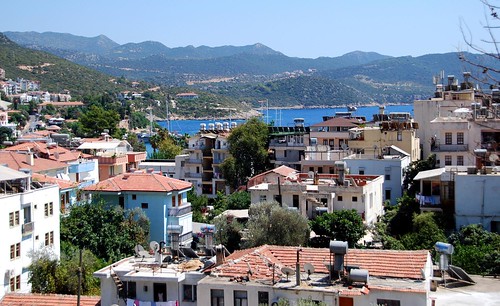
View from the roof deck of Hilal Pension in Kaş.
The only accommodation homerun we failed to hit was in Antalya. Unfortunately, I didn’t write down the name of the place in my notes, but it is the pension that the Lonely Planet says is “for the homesick,” due to its motherly owner. The room was fine and the view was spectacular, but there was no wi-fi and at 60 lira (approx. US$40), we thought it a little overpriced.
Check out all our photos from the Turkish Mediterranean:
Note: This post is dedicated to Sharon, who showed us incredible photos of Pamukkale waaay back in August of 2008. They were so incredible, in fact, that we said, “Holy crap! We have to go there!”
OK, remember that thing I said about us not being “ruins people”? I take that back. It turns out that we’re just not “Ephesus people.” In my last post, I alluded to the fact that we don’t really get excited by ruins unless there’s an incredible landscape to go along with it…and the reason why we know that to be true is because of our visit to Hierapolis and Pamukkale.
First things first: Hierapolis is another set of Greek ruins set in the hills above a site named Pamukkale. And what exactly is Pamukkale? Only the coolest travertines (white limestone made of calcium carbonate) we’ve ever seen! OK, maybe the only travertines we’ve ever seen. It looks like snow but it’s really rock.
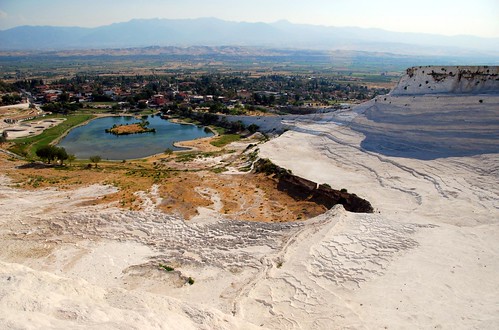
A bird’s eye view of the Pamukkale complex, with the town of Pamukkale in the background.
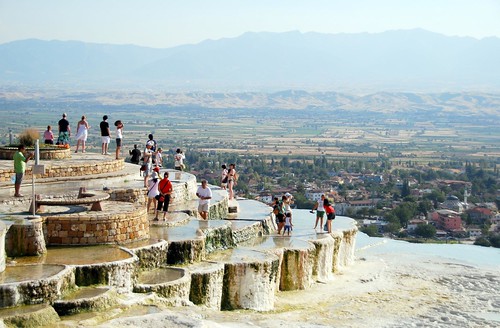
Tourists in the travertine pools.
J and I stuck to our usual M.O. and headed up to the Pamukkale/Hierapolis complex late in the afternoon, around 3PM. Unlike Ephesus, this time our plan worked—the huge crowds of Russian tourists in Speedos that flock to Pamukkale had already started filtering out of the complex, though a couple of them stuck around to pose for our photographs. ![]()
In order to get to Hierapolis, you must walk through Pamukkale’s travertine pools (barefoot, which can be pretty tough on your dogs, unless you have tough Aussie feet).
We couldn’t have timed our visit more perfectly! As we arrived in the Hierapolis area, the sun started going down, illuminating the dry grasses in the hills and creating the perfect golden light that plays a major role in every photographers’ wild, sordid fantasy.
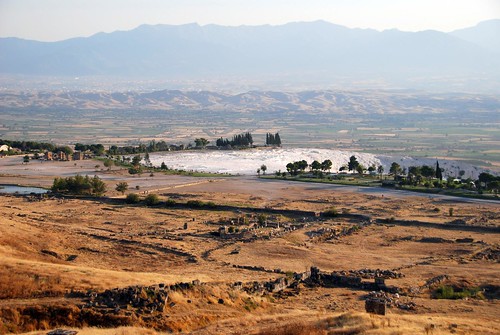
An interesting view of the travertines from the hills of Hierapolis.
This time around, we had a fabulous experience exploring Hierapolis. We got to see the remnants of an old city, including their main ceremonial street and the men’s toilet.
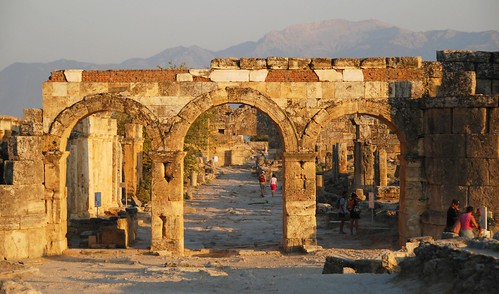
The Domitian Gate, entrance to the city of Hierapolis’ main ceremonial thoroughfare.
In fact, we were so entranced with Hierapolis’ HUGE ruins site that we almost missed the sunset! We scurried over to the travertine pools just in time to watch the sun dip below the horizon.

Sunset over Pamukkale’s travertine pools.
We’ve seen a LOT of really, really gorgeous sunsets on this trip, and—dare I say it? The sunset we watched from Pamukkale might be the best one of the trip thus far. This vistas from the top of the travertines and the golden light shining reflecting off the pools…INCREDIBLE!!! It as so awesome that we were feeling sorry for all the Speedo’ed Russians who missed this stunningly beautiful sight. We’re sensitive like that.
Since the sun had already gone down, we made our way back to town in the dark. But don’t worry—they light up the Pamukkale complex so you can still find your way down (though it was a rather painful descent with that rock).
We almost didn’t come to Pamukkale—it is a heavily touristed site and after our experience with the crowds in Ephesus, we were worried that we would be turned off. But as is the case in most situations, timing here in Pamukkale is everything.
How we got from Selcuk to Pamukkale: Paid 20 lira each for a “direct” bus from Selcuk to Pamukkale. And by “direct,” I mean we stopped in Denizli and changed to a minibus. We still haven’t quite figured out what “direct” in Turkey means…we’ve had “direct” buses that stop in every major town along the route and “direct” buses that make you transfer to a different bus. So as far as we can tell, as long as you work under the assumption that “direct” in Turkish means “indirect,” you won’t be disappointed.
Where we stayed in Pamukkale: As in Ephesus, we went with the hotel touts at the bus station and ended up at a place hilariously called The Four Seasons, also known by its Turkish name, Dort Mevsim (I say hilarious because on the way to the hotel, the owner kept passing backpackers and asking, “Are you going to The Four Seasons?” And these backpackers would look at him like, “Our clothes are riddles with holes and I haven’t brushed my hair in a month. Do I LOOK like I’m going to The Four Seasons?” Of course, little did they realize that “The Four Seasons” was actually an unfortunately-named backpacker hostel.
First of all, a note on the hotel touts: Turkish hotel touts are some of the most civilized we’ve ever met. They seem to have some sort of system, where each tout gets his turn to pitch the newly arrived travelers. No Vietnam-style crowding of the bus here! In Selcuk, the first guy who approached us named a price that was waaay too high for us. So he said, “meet my friend, he has a cheaper hotel for you.” Which is how we ended up at the Canberra Hotel. So gentlemanly!
Anyway, back to Pamukkale: we originally wanted to stay at a place called Venus Pension. The owner of The Four Seasons offered us a free ride on the promise that if we didn’t like that hotel, we would check out his place next. Classy!!! When Venus Pension turned out to be way overpriced, we went over to The Four Seasons (which was directly across the street) and agreed to stay there for 40 lira per night (US$25).
The rooms at the brightly-painted Dort Mevsim are very comfortable, and there is a nice pool (which we didn’t end up using) and a shady terrace where you eat breakfast. All in all, a great place, and if you book ahead online, it’s even cheaper!
Check out all our photos from Pamukkale and Hierapolis:
Selçuk is a very common stop on the Turkish backpacker route and it’s not hard to see why: it’s located on the Aegean but it’s pretty much the midpoint between Istanbul and the Mediterranean coast (located 9 hours from Istanbul and about the same from Fethiye), and it boasts some of the best-preserved Greco-Roman ruins this side of, well, Rome! We didn’t realize how many modern-day Turkish cities have a Greek or Roman history, but it makes sense, given Turkey’s location and the fact that the Roman empire pretty much dominated most of the lands around the Mediterranean at one point.
In fact, there are some pretty cool ruins right in town: the Selçuk Citadel and St. John’s Basilica.

View of the Selçuk Citadel, with St. John’s Basilica ruins in the foreground.
The coolest thing we learned from wandering these ruins is the fact that Romans often repurposed old construction materials (like columns) to build their cities. Romans—ancient architectural refashionistas!
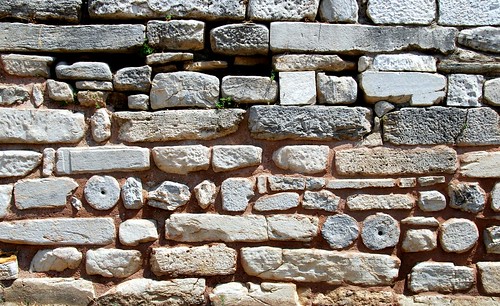
Bits of columns reused to construct the walls of St. John’s Basilica.
But the star of the ruins show is Ephesus, which is located right outside of Selçuk. It’s a neat place, with lots of major landmarks, and it allows you to imagine what life must have been like under the Roman empire.
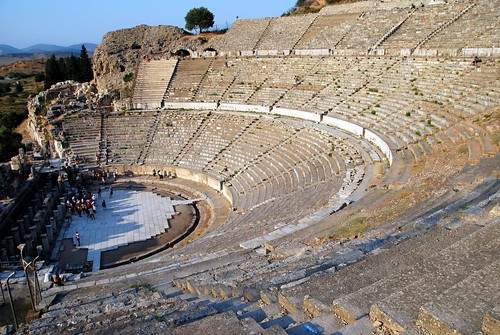
The Great Theater in Ephesus, where plays were acted out and gladiator battles fought!
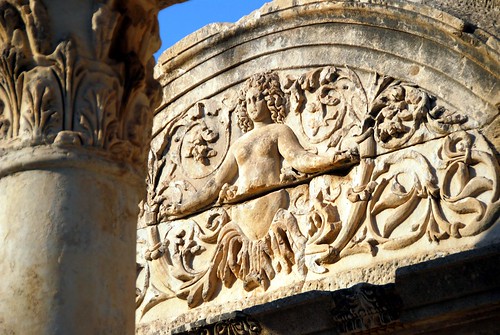
Detail, the Temple of Hadrian.
The crown jewel of Ephesus is the Library of Celsus, an imposing structure where the Romans stored thousands of “books” (i.e. scrolls). Like many classical structures (ex. the Parthenon), the design of the Library of Celsus employed some ingenious optical illusions to make the building appear more grand—the central entrance is larger than the other two flanking it, and the columns in the center are slightly bigger than the columns used on the outside of the building. The detail of the carvings on the library’s facade are really impressive.
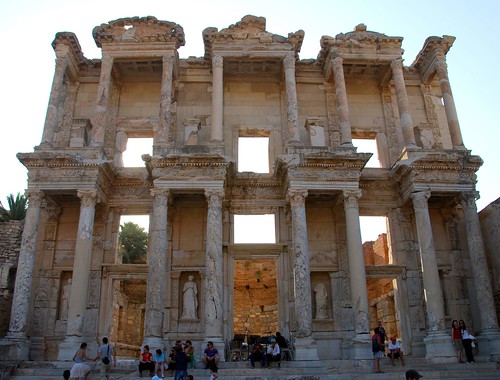
The crown jewel of Ephesus: the Library of Celsus, where the Romans stored thousands of “books” (i.e. scrolls).
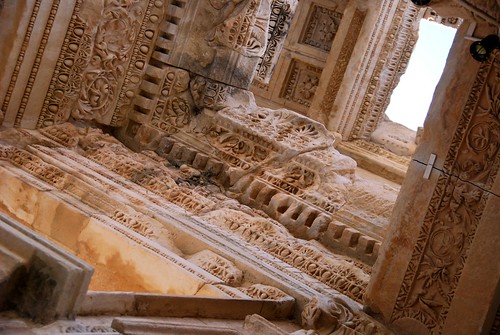
Detail, the Library of Celsus.
Our usual M.O. when visiting a major tourist site is to show up either right after opening or right before closing to avoid the masses, and we did the same with our visit to Ephesus—arriving only 2 hours before the park closes at 6pm. Unfortunately, it seems a tour group consisting of a bunch of very loud Italians had the same idea. So our experience of the ruins wasn’t that great—it felt kind of busy and loud and honestly a bit claustrophobic…but I guess that’s a pretty close approximation of what it would have been like to live in a bustling Roman city!
Most travelers stay in Selçuk for a day or two to see Ephesus before moving on. Since Selçuk was a pleasant enough town, we decided to stick around for another day and head into the countryside. A medium-sized town called Tire was having their local market on Tuesday, and though it wasn’t quite what we expected—lots of “made in China” clothing and goods—it put us within spitting distance of a town called Kaplan, where you can have lunch on the hill overlooking the town of Tire. Though the taxi ride to Kaplan made it kind of an expensive excursion just for a meal, the food was worth it! Turkey is one of the few countries in the world right now that supports its own food requirements—which is really awesome until you realize that means tomatoes, cucumbers, and olives are going to constitute the entirety of your vegetable diet. So we were understandably very excited when this beautiful little restaurant in Kaplan served us stuffed squash flowers, homemade yogurt, and a salad! With lettuce! And it was cheap (if you don’t count the taxi ride)!
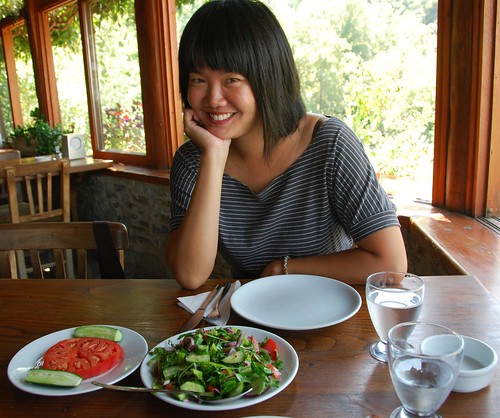
A salad worth a smile—lettuce! In Turkey! And not just some cheap iceberg—we’re talkin’ about dark green leaves in this salad!
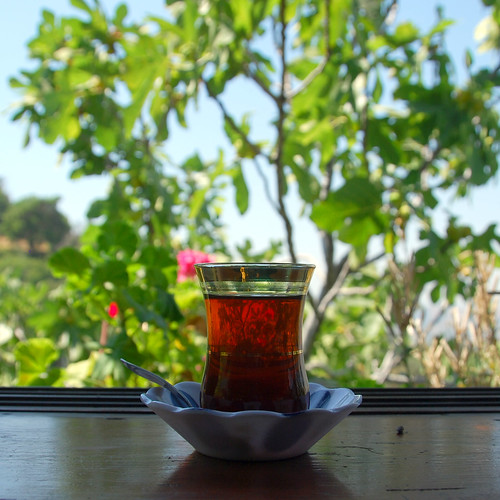
We drank this stuff all day long while we were in Turkey—Turkish tea.
Our next excursion wasn’t as successful—we heard that a town called Sirinçe was really beautiful, so we hopped the local bus (called a dolmuş) and headed for the hills. Unfortunately, it turned out to be a really lame town which was centered around a street full of shops selling tourist souvenirs. Some people are probably charmed by the whitewashed buildings, but this place was not for us.
We had a nice enough time in Selçuk, and if you’re really into ruins, then this is the place for you. I think that was the major lesson of our time in Selçuk—we’re not really “ruins people”…unless there is a really interesting landscape to go along with those ruins. ![]()
How we got from Istanbul to Selçuk: We showed up at Istanbul’s massive bus station and walked around to a few bus company offices until we found the lowest price (35 lira each from Istanbul to Izmir, where you can catch a van to Selçuk for an additional 7 lira). This was our first experience with Turkish buses—which have an excellent reputation—and the trip didn’t disappoint! A bus attendant wearing a bow tie, vest, and cummerbund (which matched the bus company’s colors!) serving us Turkish tea, cakes, and spring water on our 9 hour ride.
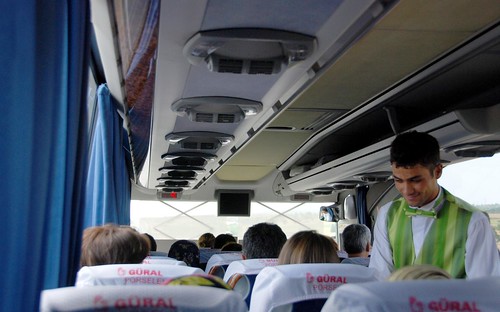
Turkish bus attendant serving tea and cakes on the drive from Istanbul to Izmir.
How we got from Selçuk to Tire, Kaplan, and Sirinçe: Took the local bus (basically a large van) from Selçuk to Tire for 6 lira and then a taxi from Tire to Kaplan (there is no public transport for this route). We also took the local bus to Sirinçe.
Where we slept in Selçuk: Turkish people are so amazing that we finally let down our guards, and for the first time on the trip, we went with the hotel touts at the bus station…and we weren’t disappointed! We stayed in a double ensuite at the Canberra Hotel for 50 lira (US$32). The room was very comfortable (and colorful!) and the views from the rooftop restaurant (where you have breakfast) were excellent. The hotel offers free rides to Ephesus, and since it is staffed by an enormous Kurdish family, inevitably some cousin or nephew will end up taking you to the ruins.
Ask any traveler about their experiences abroad and you’ll invariably get responses citing the opening of eyes, hearts, or minds. Travel IS the process of opening—exposing yourself to the influence of The Other, seeing great beauty through the eyes of another, and allowing yourself to be altered irreversibly by it.
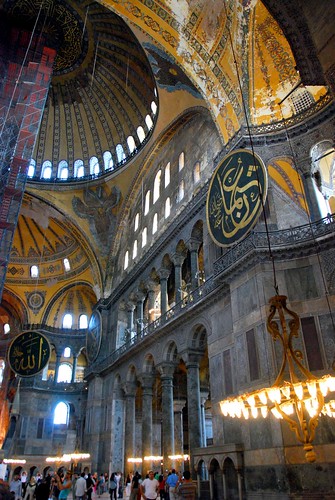
Talk about great beauty! The humbling interior of the Aya Sophia (Haghia Sophia).
Less frequently do you hear about the process of closing. I imagine it happens to most travelers at one time or another…take any open-minded person and subject them to constant touting and the less frequent but ever-threatening possibility of getting scammed or robbed, and most would end up with at least a bit of a shell—at best a wary eye, at worst a complete shut-down towards all interactions.

The Grand Bazaar in Istanbul. As a tourist, going to a market always opens you up to the possibility of an unpleasant interaction as all parties try to adhere to the old adage: buy low, sell high.
I’ll admit it: Jeremy and I grew a shell. After six months in Asia, we expected that any local who approached us on the street was trying to sell us something. We were most skeptical of those who didn’t lead with a sales pitch, but instead opened by asking where we were from or how long we had been in the country. We recognized the tactic for what it usually was—a lead to make us feel comfortable before the hard sell.
A week in Istanbul broke through that shell and smashed it into a million little pieces. Sure, there were people of the “Hello my friend, come into my carpet shop” variety, but the vast majority of our interactions with the locals here were surprisingly, I dunno, personal. If someone tried to sell us something and we politely declined, they still wanted to know where we were from, how long we would be in Turkey, and whether or not we were having a good time. It seemed like the Turkish people wanted to know all about us—even after we rejected their sales advance!

After months of Asians asking to take photos with Jeremy, in Istanbul, *I* was the celebrity. I guess they don’t see many 6 foot Chinese girls around here…
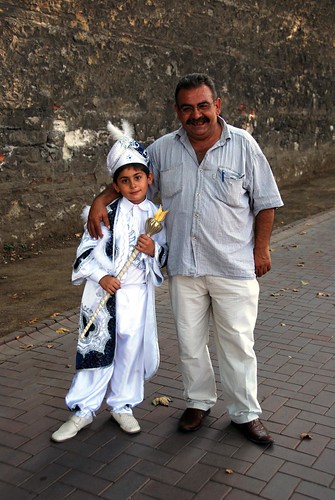
We were walking on the same sidewalk as these two when Dad proudly asked if we would like to take a picture of his mini-Sultan. Adorable!
Even in the Grand Bazaar, Istanbul’s most famous tourist market, it seemed like the selling was secondary to the bantering. To be fair, we met another traveler (who has been to Istanbul 8 times) who swears that the salesmen used to hassle you a lot more at the Grand Bazaar (he thinks that they government has instructed the sellers to back off). And, even though it’s off topic, it’s worth mentioning that we weren’t too impressed with the goods on display there (J and I walked through about 3 aisles before turning to each other and saying, “How much of this stuff do you think was made in China?”). But despite stall after stall of identical souvenirs for sale, our wanderings through this 500-year-old market were fascinating. Again, it was because of the people. One Turkish vendor in the spice market even engaged me in competent (though heavily accented) conversational Mandarin.

Spices in the (surprise!) spice bazaar.
Turkey is a stunning country. The landscape is incredible and the architecture can knock you off your feet. But despite all of this physical beauty, it’s the people—so full of love and graciousness that they could pierce through a 12FOOT3 shell—that will really get to you.
